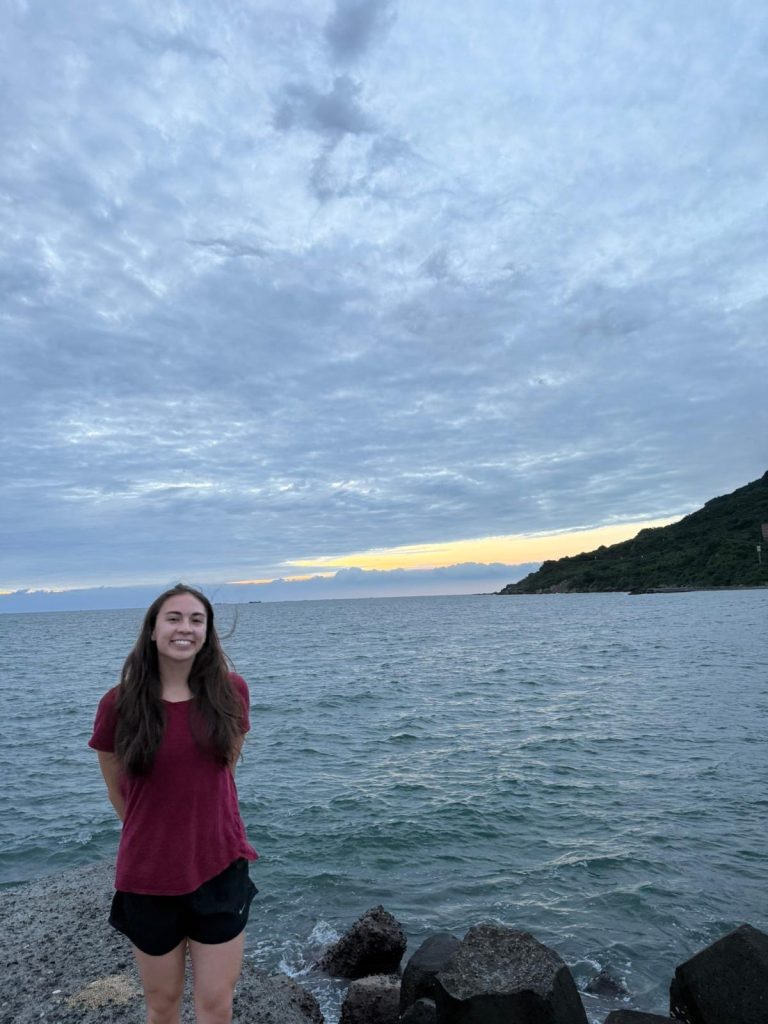We hit many temples in Kaohsiung that were built within a variety of time periods. On the first visit, we saw a pair of pagodas built in the 1970’s called the Dragon and Tiger Pagodas. These pagodas are an iconic attraction in Taiwan built by Lotus Lake, right next to some more ancient temples that we also saw/visited. The bridge to the pagodas forms a zig-zag pattern to prevent the spirtual presences from coming in, as ghosts are said to only move in a straight line. To properly explore the pagodas, you enter the dragon’s mouth and leave through the tiger’s. You then travel through a tunnel lined by two sets of sculpted murals: one outlines Confucian principles of filial piety, and the other shows the hellish consequences in failing to meet these standards. We climbed all 100 steps across the six stories available to the public (the seventh is closed off) and were rewarded with a panoramic view of the lake and its surrounding cityscape. The proximity to the rooftops also allowed us to examine the ceramic dragons that similarly adorn temple rooftops more closely. The tiger pagoda is laid out in the same manner, with the tunnel leading out showing scenes and deities of heaven.




Our next stop was further down the shore of Lotus Lake, Zuoying Yuandi Temple. A long bridge lined with 36 officers standing guard, sometimes on beasts of legend (peek the guy on the far right picture), led up to a large statue of Xuantian Shang-di. He is a Daoist deity who was once a real warrior, and his temple consisted two floors in the main hall and some other subsidiary halls filled with all sorts of games, fortune telling machines, and other attractions aimed at kids. Upon entering the main hall, there is a case holding a bone-like snake figure with a turtle in front of it. The material is hopefully stone, but it was carved with the smallest gashes to add texture to the bodies of the animals in a way that makes it feel like it was once living. In fact, other temples often have a real live snake inside. I wish I could see that!



Before we went back to the bus to head to our next stop, Prof. Young, Malli, and I took a quick detour to see the connected Tzu Chi Temple. I didn’t know this at the time, but this temple homes the god of medicine, Baosheng Dadi. The first thing I noticed was the nine-headed dragon laid into the stairway leading to the front entrance. Nine is somewhat of an auspicious number, first given that it is a multiple of three but also there are nine tiers of heaven according to Daoism. I also happened upon another interesting detail unique to this temple after examining the altar more closely and approaching it from the right side. Underneath the alter was a tiger incased in plastic sitting with a kneeling cushion and incense burner placed before it. Normally, a tiger is placed beneath Tu Di Gong/the earth god of the place you are in, but there was no image on top of the altar. I wonder whether this is something that used to be in the temple that did not make the migration or whether the direction the worshipper would face had anything to do with the deity’s presence/lack thereof. Lastly, I noted that the figures painted on the doors were not all men but rather smiling women. These were likely maids for the god of medicine or wives of the martial gods that also guarded the doors, which you don’t see very often. I’ve started to take more notice of the presence of gender in temples and the roles of women within different religions.


We took the bus to a nearby Mazu temple that was three stories tall. There was a lot to explore, so once again we started at the top and worked our way to the bottom. Mazu was of course the primary deity on the first floor, and I believe the next floor was Guanyin and the last might have been the Jade Emperor. I used the moon blocks and divination sticks on the third floor and got an immediate answer, but some of the people did not so I found myself a stool and took the chance for a little sitting break. It put in the shoes of a regular temple-goer for a moment, imagining what it would be like to come to the temple as part of my day to day: whether to divine the answers to a question or to just sit and relax.
I noticed as we moved between the floors that there were numbers stuck to various surfaces in the temple, and I learned that these numbers were the prices one could pay to have their name engraved on that part of the temple in order to receive interminable blessings. Some of the numbers were as high as the millions, particularly on the doors with deities on them, but even more surprising was the number of places that did not have a price but a name written on them. This shows that outside of more typical business transatctions such as the purchasing of offerings and amulets, some temples receive a good portion of their revenue from generous donations.



The day finished up with an evening on the beach. Many people were also headed there to watch the sunset, so it wasn’t too hard to find the best place to stop and find our own spot. While cloudy, the ocean was still beautiful, and the sun still shone in nice pinks and reds (later on than seen in the pictures below) that spread just along the horizon line. The water was warm but honestly not too inviting to me personally as I was sweating so much from the journey. Luckily, I caught a slight breeze that really helped me relax and let loose after all the traveling we had done throughout the day. What a great way to end our first full day in Kaohsiung!

